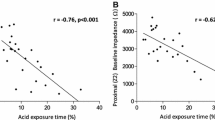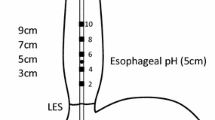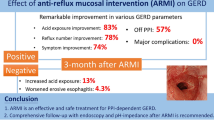Abstract
Background
Endoscopic full-thickness plication allows transmural suturing at the gastroesophageal junction to recreate the antireflux barrier. Multichannel intraluminal impedance monitoring (MII) can be used to detect nonacid or weakly acidic reflux, acidic swallows, and esophageal clearance time. This study used MII to evaluate the outcome of endoscopic full-thickness plication.
Methods
In this study, 12 subsequent patients requiring maintenance proton pump inhibitor therapy underwent endoscopic full-thickness plication for treatment of gastroesophageal reflux disease. With patients off medication, MII was performed before and 6-months after endoscopic full-thickness plication.
Results
The total median number of reflux episodes was significantly reduced from 105 to 64 (p = 0.016). The median number of acid reflux episodes decreased from 73 to 43 (p = 0.016). Nonacid reflux episodes decreased from 23 to 21 (p = 0.306). The median bolus clearance time was 12 s before treatment and 11 s at 6 months (p = 0.798). The median acid exposure time was reduced from 6.8% to 3.4% (p = 0.008), and the DeMeester scores were reduced from 19 to 12 (p = 0.008).
Conclusion
Endoscopic full-thickness plication significantly reduced total reflux episodes, acid reflux episodes, and total reflux exposure time. The DeMeester scores and total acid exposure time for the distal esophagus were significantly improved. No significant changes in nonacid reflux episodes and median bolus clearance time were encountered.









Similar content being viewed by others
References
Dent J, El-Serag HB, Wallander MA, Johansson S (2005) Epidemiology of gastro-oesophageal reflux disease: a systematic review. Gut 54:710–717
Vakil N, van Zanten SV, Kahrilas P, Dent J, Jones R (2006) The Montreal definition and classification of gastroesophageal reflux disease: a global evidence-based consensus. Am J Gastroenterol 101:1900–1920
Klinkenberg-Knol EC, Festen HP, Meuwissen SG (1995) Pharmacological management of gastro-oesophageal reflux disease. Drugs 49:695–710
Pace F, Santalucia F, Bianchi Porro G (1991) Natural history of gastro-oesophageal reflux disease without oesophagitis. Gut 32:845–848
Mainie I, Tutuian R, Shay S, Vela M, Zhang X, Sifrim D, Castell DO (2006) Acid and nonacid reflux in patients with persistent symptoms despite acid suppressive therapy: a multicentre study using combined ambulatory impedance-pH monitoring. Gut 55:1398–1402
Sifrim D, Castell D, Dent J, Kahrilas PJ (2004) Gastro-oesophageal reflux monitoring: review and consensus report on detection and definitions of acid, non-acid, and gas reflux. Gut 53:1024–1031
Zerbib F, Duriez A, Roman S, Capdepont M, Mion F (2008) Determinants of gastro-oesophageal reflux perception in patients with persistent symptoms despite proton pump inhibitors. Gut 57:156–160
Schilling D, Kiesslich R, Riemann JF, Riemann JF (2005) Endoluminal therapy of GERD with a new endoscopic suturing device. Gastrointest Endosc 62:37–43
Pleskow D, Rothstein R, Kozarek R, Haber G, Gostout C, Lembo A (2006) Endoscopic full-thickness plication for the treatment of GERD: long-term multicenter results. Surg Endosc 21:439–444
McClusky DA, Khaitan L, Swafford VA, Smith CD (2007) Radiofrequency energy delivery to the lower esophageal sphincter (Stretta procedure) in patients with recurrent reflux after antireflux surgery: can surgery be avoided? Surg Endosc 21:1207–1211
Triadafilopoulos G, Di Baise JK, Nostrant TT, Stollman NH, Anderson PK, Wolfe MM, Rothstein RI, Wo JM, Corley DA, Patti MG, Antignano LV, Goff JS, Edmundowicz SA, Castell DO, Rabine JC, Kim MS, Utley DS (2002) The Stretta procedure for the treatment of GERD: 6- and 12-month follow-up of the U.S. open label trial. Gastrointest Endosc 55:149–156
Tam WCE, Schoeman MN, Zhang Q, Dent J, Rigda R, Utley D, Holloway RH (2003) Delivery of radiofrequency energy to the lower oesophageal sphincter and gastric cardia inhibits transient lower oesophageal sphincter relaxations and gastro-oesophageal reflux in patients with reflux disease. Gut 52:479–485
Birk J, Pruitt R, Haber G, Raijman I, Baluyut A, Meiselman M, Sedghi S (2009) The Plicator procedure for the treatment of gastroesophageal reflux disease: a registry study. Surg Endosc 23:423–431
Corley DA, Katz P, Wolfe MM, Stefan A, Patti M, Rothstein R, Edmundowicz S, Kline M, Mason R, Wolfe MM (2003) Improvement of gastroesophageal reflux symptoms after radiofrequency energy: a randomized, sham-controlled trial. Gastroenterology 125:668–676
Pleskow D, Rothstein R, Kozarek R, Haber G, Gostout C, Lembo A (2008) Endoscopic full-thickness plication for the treatment of GERD: five-year long-term multicenter results. Surg Endosc 22:326–332
Deviere J, Costamagna G, Neuhaus H, Voderholzer W, Louis H, Tringali A, Marchese M, Fiedler T, Darb-Esfahani P, Schumacher B (2005) Nonresorbable copolymer implantation for gastroesophageal reflux disease: a randomized sham-controlled multicenter trial. Gastroenterology 128:532–540
Rothstein R, Filipi C, Caca K, Pruitt R, Mergener K, Torquati A, Haber G, Chen Y, Chang K, Wong D, Deviere J, Pleskow D, Lightdale C, Ades A, Kozarek R, Richards W, Lembo A (2006) Endoscopic full-thickness plication for the treatment of gastroesophageal reflux disease: a randomized, sham-controlled trial. Gastroenterology 131:704–712
Schiefke I, Zabel-Langhennig S, Neumann S, Feisthammel J, Moessner J, Caca K (2005) Long-term failure of endoscopic gastroplication (EndoCinch). Gut 54:752–758
von Renteln D, Brey U, Riecken B, Caca K (2008) Endoscopic full-thickness plication (Plicator) with two serially placed implants improves esophagitis, reduces PPI use and esophageal acid exposure. Endoscopy 40:173–178
von Renteln D, Schiefke I, Fuchs K, Raczynski S, Philipper M, Breithaupt W, Caca K, Neuhaus H (2008) Endoscopic full-thickness plication for the treatment of gastroesophageal reflux disease by application of multiple plicator implants: a multicenter study. Gastrointest Endosc 68:833–844
Sgromo B, Irvine LA, Cuschieri A, Shimi SM (2008) Long-term comparative outcome between laparoscopic total Nissen and Toupet fundoplication: symptomatic relief, patient satisfaction, and quality of life. Surg Endosc 22:1048–1053
Johnson LF, De Meester TR (1974) Twenty-four-hour pH monitoring of the distal esophagus: a quantitative measure of gastroesophageal reflux. Am J Gastroenterol 62:325–332
Shay S, Richter JE (1998) Importance of additional reflux events during esophageal acid clearing. Dig Dis Sci 43:95–102
Shay S, Tutuian R, Sifrim D, Vela M, Wise J, Balaji N, Zhang X, Adhami T, Murray J, Peters J, Castell D (2004) Twenty-four-hour ambulatory simultaneous impedance and pH monitoring: a multicenter report of normal values from 60 healthy volunteers. Am J Gastroenterol 99:1037–1043
Johnsson F, Joelsson B, Isberg PE (1987) Ambulatory 24-hour intraesophageal pH-monitoring in the diagnosis of gastroesophageal reflux disease. Gut 28:1145–1150
Emde C, Garner A, Blum AL (1987) Technical aspects of intraluminal pH-metry in man: current status and recommendations. Gut 28:1177–1188
Fletcher J, Wirz A, Henry E, McColl KEL (2004) Studies of acid exposure immediately above the gastro-oesophageal squamocolumnar junction: evidence of short segment reflux. Gut 53:168–173
Pandolfino JE, Zhang Q, Schreiner MA, Ghosh S, Roth MP, Kahrilas PJ (2005) Acid reflux event detection using the Bravo wireless versus the Slimline catheter pH systems: why are the numbers so different? Gut 54:1687–1692
Bredenoord AJ, Weusten BLAM, Smout AJ (2005) Symptom association analysis in ambulatory gastro-oesophageal reflux monitoring. Gut 54:1810–1817
Sifrim D, Silny J, Holloway RH, Janssens J (1999) Patterns of gas and liquid reflux during transient lower oesophageal sphincter relaxation: a study using intraluminal electrical impedance. Gut 44:47–54
Tutuian R, Castell DO (2003) Use of multichannel intraluminal impedance to document proximal esophageal and pharyngeal nonacidic reflux episodes. Am J Med 115:119–123
Sifrim D, Dupont L, Blondeau K, Tack J, Janssens J (2005) Weakly acidic reflux in patients with chronic unexplained cough during 24-hour pressure, pH, and impedance monitoring. Gut 54:449–454
Tutuian R, Castell DO (2004) Combined multichannel intraluminal impedance and manometry clarifies esophageal function abnormalities: study in 350 patients. Am J Gastroenterol 99:1011–1019
Bredenoord AJ, Weusten BL, Timmer R, Smout AJ (2006) Characteristics of gastroesophageal reflux in symptomatic patients with and without excessive esophageal acid exposure. Am J Gastroenterol 101:2470–2475
Bredenoord AJ, Weusten BLAM, Sifrim D, Timmer R, Smout AJ (2004) Aerophagia, gastric, and supragastric belching: a study using intraluminal electrical impedance monitoring. Gut 53:1561–1565
Balaji NS, Blom D, De Meester TR, Peters JH (2003) Redefining gastroesophageal reflux (GER). Surg Endosc 17:1380–1385
Gruebel C, Linke G, Tutuian R, Hebbard G, Zerz A, Meyenberger C, Borovicka J (2008) Prospective study examining the impact of multichannel intraluminal impedance on antireflux surgery. Surg Endosc 22:1241–1247
del Genio G, Tolone S, del Genio F, Rossetti G, Brusciano L, Pizza F, Fei L, del Genio A (2008) Total fundoplication controls acid and nonacid reflux: evaluation by pre- and postoperative 24-h pH-multichannel intraluminal impedance. Surg Endosc 22:2518–2523
Torquati A, Richards WO (2007) Endoluminal GERD treatments: critical appraisal of current literature with evidence-based medicine instruments. Surg Endosc 21:697–706
Hogan WJ (2006) Clinical trials evaluating endoscopic GERD treatments: is it time for a moratorium on the clinical use of these procedures? Am J Gastroenterol 101:437–439
Freston JW, Triadafilopoulos G (2004) Review article: approaches to the long-term management of adults with GERD-proton pump inhibitor therapy, laparoscopic fundoplication or endoscopic therapy? Aliment Pharmacol Ther 19:35–42
Gerson LB, Triadafilopoulos G (2001) Proton pump inhibitors and their drug interactions: an evidence-based approach. Eur J Gastroenterol Hepatol 13:611–616
Rosen R, Nurko S, Furuta GT (2003) Impeding gastroesophageal refluxate: a new application of an old medication. Gastroenterology 125:984–985
Pearl J, Marks J (2007) Endoluminal therapies for GERD: are they dead? Surg Endosc 21:1–4
Strate U, Emmermann A, Fibbe C, Layer P, Zornig C (2008) Laparoscopic fundoplication: Nissen versus Toupet two-year outcome of a prospective randomized study of 200 patients regarding preoperative esophageal motility. Surg Endosc 22:21–30
Guerin E, Betroune K, Closset J, Mehdi A, Lefebvre JC, Houben JJ, Gelin M, Vaneukem P, El Nakadi I (2007) Nissen versus Toupet fundoplication: results of a randomized and multicenter trial. Surg Endosc 21:1985–1990
Biertho L, Sebajang H, Anvari M (2006) Effects of laparoscopic Nissen fundoplication on esophageal motility: long-term results. Surg Endosc 20:619–623
Oelschlager BK, Lal DR, Jensen E, Cahill M, Quiroga E, Pellegrini CA (2006) Medium- and long-term outcome of laparoscopic redo fundoplication. Surg Endosc 20:1817–1823
Youssef YK, Shekar N, Lutfi R, Richards WO, Torquati A (2006) Long-term evaluation of patient satisfaction and reflux symptoms after laparoscopic fundoplication with Collis gastroplasty. Surg Endosc 20:1702–1705
Biertho L, Sebajang H, Allen C, Anvari M (2006) Does laparoscopic Nissen fundoplication lead to chronic gastrointestinal dysfunction? Surg Endosc 20:1360–1363
Zehetner J, Holzinger F, Breuhahn T, Geppert C, Klaiber C (2006) Five-year results of laparoscopic Toupet fundoplication as the primary surgical repair in GERD patients: is it durable? Surg Endosc 20:220–225
Papasavas PK, Keenan RJ, Yeaney WW, Caushaj PF, Gagne DJ, Landreneau RJ (2003) Effectiveness of laparoscopic fundoplication in relieving the symptoms of gastroesophageal reflux disease (GERD) and eliminating antireflux medical therapy. Surg Endosc 17:1200–1205
Contini S, Bertele A, Nervi G, Zinicola R, Scarpignato C (2002) Quality of life for patients with gastroesophageal reflux disease 2 years after laparoscopic fundoplication. Evaluation of the results obtained during the initial experience. Surg Endosc 16:1555–1560
Mainie I, Tutuian R, Agrawal A, Adams D, Castell DO (2006) Combined multichannel intraluminal impedance pH monitoring to select patients with persistent gastro-oesophageal reflux for laparoscopic Nissen fundoplication. Br J Surg 93:1483–1487
Disclosures
Daniel von Renteln, Arthur Schmidt, and Bettina Riecken have no conflict of interest or financial ties to disclose. Karel Caca declares that he has served in the capacity as a member of the NDO Surgical, Inc. Medical Advisory Board from October 3, 2006 to October 3, 2007 and has received honoraria for speaking and training. No research funding or any other financial allocation was received regarding this study.
Author information
Authors and Affiliations
Corresponding author
Rights and permissions
About this article
Cite this article
von Renteln, D., Schmidt, A., Riecken, B. et al. Evaluating outcomes of endoscopic full-thickness plication for gastroesophageal reflux disease (GERD) with impedance monitoring. Surg Endosc 24, 1040–1048 (2010). https://doi.org/10.1007/s00464-009-0723-9
Received:
Accepted:
Published:
Issue Date:
DOI: https://doi.org/10.1007/s00464-009-0723-9




